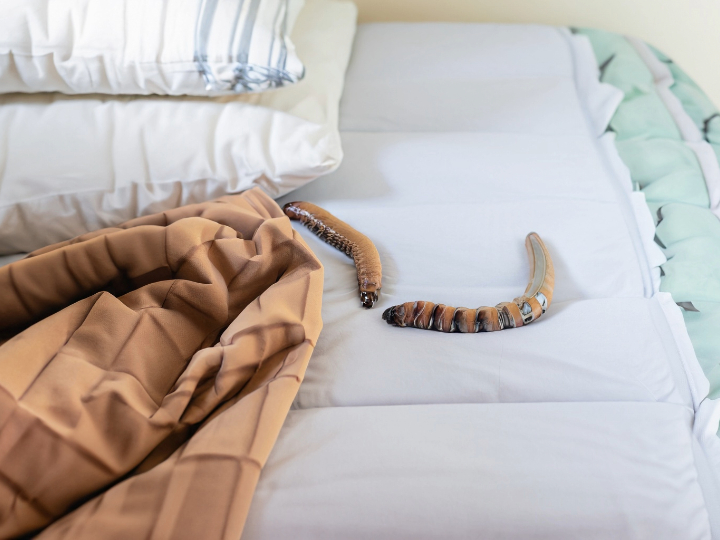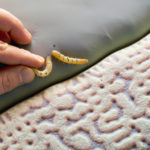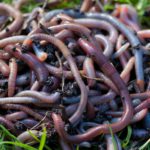Bed worms: what are they?
Bed worms are a home pest that often go unnoticed, silently interfering with our sleep and causing our living areas to become less hygienic. Awareness and management are essential about bed worm for keeping your house tidy and cozy. Bed worms are the subject of this in-depth tutorial, which covers everything from identification and prevention to practical eradication techniques. Let’s set out on a quest to uncover the mystery of these mysterious guests and recover the haven of sound sleep.
Table of contents
- Bed worms: what are they?
- Recognizing Bed Worms
- Bed Worm Types
- Physical characteristics
- Habitat and Behavior
- Infestation Indications
- Control and Preventive Measures of Carpet Beetles Bed Worms
- Clothes Moths
- Habitat and Behavior
- Control and Preventive Measures against clothes moths Bed Worms
- Dust mites
- Behavior and Habitat
- When Dust Mites Are Present
- Control and Preventive Measures against dust mites bed worms
- Frequently Asked Questions about Bed Worms
- In summary
Recognizing Bed Worms
Bed worms are a broad category of pests that includes clothing moths, carpet beetles, and various types of mites. Identification is the first step in a successful elimination process. An infestation is indicated by tiny holes in materials, silk webbing, and the appearance of larvae or cocoons. Understanding the distinct characteristics of various bed worm varieties is critical for targeted elimination efforts.

Bed Worm Types
Carpet Beetles
Carpet beetles are a class of bed worms that consume the natural fibers found in textiles, carpets, and bedding. For efficient pest control and prevention, carpet beetle identification is essential. Small, oval-shaped insects, carpet beetles are members of the Dermestidae family. These pests contaminate and harm a wide range of household items, particularly those made of natural fibers. This information will assist you in recognizing carpet beetles.

Physical characteristics
Size and Shape
Adult carpet beetles usually have a modest length, measuring between 1/16 and 1/8 inch.
Their bodies are relatively flat and have an oval or circular appearance.
Coloration
Adult carpet beetles can have a variety of colors, but most of them are spotty.
Some species have a unique pattern on their scales that combines black, brown, and white.
Larvae
The carpet beetle larvae have thick hairs.
The larvae typically have spots or stripes, and their hue can vary from light brown to dark brown.
Adult carpet beetles have wings.
There can be differences in the way the wings look, and certain species might not fly very often.
Habitat and Behavior
Feeding Habits
Natural fibers such as wool, silk, fur, and feathers are among the many items that carpet beetles consume.
If mixed with natural fibers, these bed worms might also eat synthetic fibers.
Preferred Environments
Homes are a frequent habitat for carpet beetles, particularly those regions with natural fibers.
They can contaminate garments, rugs, carpets, upholstery, and stored goods like plush animals and blankets.
Life Cycle
Carpet beetles go through four stages in their life cycle: the egg, larva, pupa, and adult.
The destructive stage, which damages household things, is the larvae.
Infestation Indications
Damage that is Visible
Search for asymmetrical punctures or areas of impairment on apparel, rugs, and further vulnerable commodities.
Adult Beetles
The presence of adult carpet beetles, particularly close to windows or other sources of light, may be a sign of an infestation.
Larvae and Skins That Shed
In areas where infestation is suspected, such as dark, undisturbed corners and storage spaces, look for larvae or shed skins.
Control and Preventive Measures of Carpet Beetles Bed Worms
Continual Cleaning
Regularly vacuum upholstery, carpets, and other possible breeding grounds to get rid of bed worms.
Observe neglected locations where dirt and dust build up.
Storage Procedures
Clothes and other natural fiber products should be kept in sealed containers.
Stored goods should be kept dry and cool to prevent infestation.
Termite Control
Consider applying pesticides intended for carpet beetle control if an infestation is found.
For serious infestations, professional pest control services could be required.
Clothes Moths
The Tineidae family includes clothes moths. There are two main species : the Tineola bisselliella, or webbing clothes moth, and the Tinea pellionella, or casemaking clothes moth. This guide will assist you in identifying clothes moths:
Physical characteristics
Adult clothes moths are small, with a length of between 1/2 and 1/4 inch. Their wings appear small and slender. Adult moths usually have a golden or tan coloration. The wings of these bed worms have spotty pattern. Clothes moths have long, thin antennae. While the female moth’s antennae are straight, the male moth’s are frequently feathery or comb-like.
Larvae
Clothes moth larvae are cylindrical in shape and have a creamy white appearance.
As they feed, the larvae spin silk webbing to form protective tubes or casings.
Habitat and Behavior
Clothes moth larvae consume natural fibers, specifically fur, feathers, silk, and wool. They have a reputation for causing harm to textiles such as upholstery, carpets, and clothes.
Preferred Environments
Dark, uninhabited regions with natural fibers are ideal for clothes moth growth. Storage spaces, drawers, and closets are common places for infestations. Clothes moths go through four phases in their life cycle: the egg, larva, pupa, and adult. The damaging stage that damages textiles are the larvae.
Infestation Indications
Visible Damage
Inspect clothing for any odd holes or damaged patches, particularly in wool or silk pieces. Additionally, webbing clothing moths create silk webbing on the surface of infected fabrics. Moreover, larvae of clothing moths use silk and fabric fibers to form tubular casings known as casemaking. Furthermore, infested regions should be checked for the presence of small, white larvae or their cases.
Control and Preventive Measures against clothes moths Bed Worms
Continual Cleaning
Vacuum and clean closets, drawers, and storage spaces on a regular basis. Keep an eye out for apparel, particularly pieces composed of natural fibers.
Storage Procedures
Additionally, clothes should be kept in garment bags or airtight containers. As a deterrent, think about utilizing cedar products or mothballs.
Control of Humidity and Temperature
Keep your surroundings dry and cool since clothes moths prefer damp environments. Apply dehumidifiers if required.
Pest Control
Insecticides indicated for clothes moth control should be used if an infestation is found. However, for serious infestations, professional pest control services could be required for killing these bed worms.
Dust mites
Dust mites are little arachnids that are members of the Pyroglyphidae bed worms family. Additionally, these microscopic organisms, which feed on skin flakes shed by people and animals, are frequent household allergies. Even though they are invisible to the unaided eye, certain indicators can suggest their existence. This guide will assist you in recognizing dust mites:
Features
Size: Dust mites are incredibly tiny, with a length of 0.2 to 0.3 millimeters.
They require the use of a microscope to be seen.
The eight legs of a dust mite are attached to a translucent or semi-transparent body.
They don’t have the clear body segmentation that insects frequently have.
Behavior and Habitat
Optimal Setting
Environments with high humidity, usually above 50%, are ideal for dust mite growth.
The ideal temperature range for them is 68°F to 77°F (20°C to 25°C), as they like warm temperatures.
Feeding Patterns
Dust mites mostly consume dead skin cells that people and animals excrete.
They also eat dust-borne germs and fungi.
Location: Dust mites are common in places like upholstered furniture, carpets, curtains, mattresses, pillows, and beds. Dusty places are their favorite places of these bed worms.
When Dust Mites Are Present
Reactions Allergic to
Asthma and hay fever are two prevalent respiratory conditions and allergic reactions that are brought on by dust mites. Relentless allergy symptoms could be a sign of dust mite infestation, particularly indoors.
Microscopic Examination:
Dust mites in dust samples can be observed using a microscope or magnifying lens, albeit this method is not feasible for routine identification.
Dust Accumulation
Visible dust accumulations may offer dust mites a good place to live.
Control and Preventive Measures against dust mites bed worms
Lowering the Humidity
Keep the relative humidity of your interior spaces below 50% to discourage dust mites.
When in damp environments, use dehumidifiers.
Frequent Cleaning: On a regular basis, wash curtains, sheets, and pillowcases in hot water (above 130°F/54°C).
Use a vacuum with a HEPA filter to clean upholstered furniture, carpets, and rugs.
Encasements: To lessen exposure to dust mite allergens, use allergen-proof mattress and pillow encasements.
Air Purifiers: To remove allergens from dust mites and other airborne particles, think about utilizing air purifiers with HEPA filters.
Prevention Strategies of bed worms
Stopping bed worm infestations is important for keeping a clean and healthy living space. Being proactive means doing things like regular cleaning, storing clothes, and buying a mattress cover. Taking care of any problems with moisture in your home can also keep some pests away. To avoid getting bed worms, you need to keep your home clean and practice good hygiene.
Bed worms are the last thing anyone wants when they’re trying to sleep. Small, unwanted guests like these can turn a safe place into a stressful one. In this long book, we’ll learn all about bed worms, from how to recognize them to how to keep them from coming back and, most importantly, how to get rid of them effectively. Let’s get into the specifics so that your bed stays a place to rest and not a battleground for these annoying guests.
Frequently Asked Questions about Bed Worms
The following addresses the most frequent queries regarding bed worms:
What appearance do bed worms have?
These are the small larvae of bed worms.
What eradicates bed bugs?
Bed worms can be effectively killed by steam washing.
Do beddings harbor bed worms?
Wool, silk, fur, and leather blankets and carpets are home to bed worms.
Are worms in beds visible?
Despite being small, they are visible to the unaided eye.
How dangerous are bed bugs?
Even though they don’t transmit illness, bed worms can be physically uncomfortable and interfere with restful sleep.
What rapidly eradicates bed worms?
Firstly, bed worms are instantaneously killed by extreme heat. Additionally, excellent steam cleaners are widely available on the internet.
In summary
The bed worms are very bad for our health and the way we live. The first thing that can help us get back to sleep is being aware of their types. In addition, taking preventative steps like sealing cracks and crevices can be useful. It’s also important to use effective methods of elimination, like vacuuming regularly and washing bedding. Also, taking proactive steps and finding these problems early are necessary to keep them from coming back. When you’re trying to get rid of bed worms in your home, remember that you will have wonderful dreams afterward. Bookmark our page to get latest information about all the insects that can affect you.




